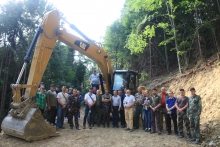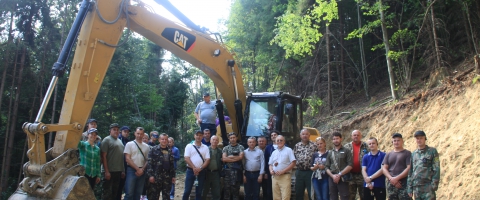
“We must co-exist in harmony with nature,” explains Lesya Loyko, director of the NGO “FORZA” which focuses on building sustainable economic, environmental, and social aspects of the natural resource management and community development. “And, we find extremely important to increase the knowledge and build the capacity of forestry professionals to sustainably utilize our natural resources.” In order to advance this goal, participants from Belarus, Bosnia and Herzegovina, Macedonia, Montenegro, Serbia and Ukraine came together in Western Ukraine to look at ways to build more sustainable, economically-efficient, and environmentally-friendly forest roads. Roads engineers, foresters, university instructors and NGOs discussed different ways roads are constructed and maintained in their countries.
Ensuring good, upfront construction can help ensure fewer problems long-term. Sometimes adding a little more cost upfront can reduce the expenses over the long-term and reduce impact on the environment. “We don’t construct forest roads,” explains Ranko Kankaras, Head of the Forestry Directorate for Montenegro. “We work with private contractors for this. But, we are responsible for maintaining them.” The group discussed ways to ensure good construction upfront to ensure the long-term success of a sustainable road.
Maintenance is perhaps the most important and challenging aspect of roads. Dr. Volodymyr Korzhov, first deputy director of the Ukrainian Mountain Research Institute of Mountain Forestry, shared that Ukrainians “know how to build good forest roads, they just aren’t well maintained.” The lack of resources to maintain roads can encourage construction choices that impact biodiversity. For example, in order to increase the time between upkeep, ditches may be constructed much deeper than most international standards in order to accommodate the typical runoff along with sediment that collects there over time.
“In the US, we are closing forest roads,” explained trainer Gordon Keller, retired USFS roads expert with experience working in countries around the world, “because we haven’t the resources to maintain all the roads we have constructed.”
Good construction depends on understanding the natural resources and impacts in an area. U.S. Forest Service roads experts use interdisciplinary teams of hydrologists, soil scientists, biologists and other specialists to get ideas for how to best design roads to be more environmentally sensitive. Some parts of Western Ukraine face a growing problem of dying Spruce trees. As these are the primary stabilizers for slopes in some areas, this could become a long-term concern. Interacting with forest experts is an important way to plan for replacement of vegetation to structurally maintain the integrity of the road and its slopes, and to help sustain the natural resources.
During site visits in the Lviv and Ivano-Frankivsk regions of Ukraine, trainers and participants looked at bridges, culverts, and road surfaces to assess ways to better construct, maintain, and, in some cases, to reduce the risk and potential future failures while improving road-use safety. In addition to good maintenance, keeping water off the road is the key to the life of any road. “The three most important things for good roads are drainage, drainage, and drainage,” jokes Keller. Using best practices in road construction and maintenance can be less costly and more cost-effective, particularly in the long run.
“We have learned to think like water,” adds Erica Borum, co-trainer and civil engineer from the White River National Forest in Colorado. “One way to do this to create infrastructure that models nature.” For example, rather than rerouting water through complicated systems, we look at the way water naturally wants to flow and we modify the infrastructure to accommodate this. Figure 1 shows a traditional culvert and Figure 2 is an example of an environmentally-friendly road-stream crossing. The more environmentally friendly approach not only mimics nature by maintaining connectivity, but it requires less maintenance, is less likely to fail, and is likely to be more economical in the long-run.
Roads frequently become barriers to animals by disconnecting their habitats. In busy areas, tunnels and bridges may be constructed to allow safe animal passage under or over roads [see Figure 3 for example]. One challenge is constructing them. “In Serbia, we include animal passages in our road designs,” explained Milorad Danilovic, associate professor at the University of Belgrade, Faculty of Forestry, “but often they are not included in the actual construction.” Keller explained we have similar issues in the US, but with these crossings included in the major roads and high standard road projects.
Forest roads are also critical connectors for rural communities. Even simple changes to design can make a difference to prevent road closures and cut-off from outside areas, which also impacts local economies. Finally, roads open up the forests for many uses from commercial activity to recreation and for access to places for spiritual/emotional healing for those returning from war. They serve as fire breaks and can allow for quick and easy access by firefighters to quickly put out forest fires.
A participant from Serbia noted that, “Ukraine and Serbia use similar road construction techniques, but this is the first time I have seen a combination of materials like cement and wood, used together.” Still another noted that the standards used must take into account not only the local environment, but the availability of materials on the market. “We don’t have large pipe material available in our country.” “We have a lot of problems with drainage, especially in the mountains” said one Ukrainian. “A lot of information [learned during the training] is new for us. It will be interesting to explore these approaches in our area.”
Key Lessons
- Water erodes; it must be kept off the roads.
- Build roads far away from streams as a sustainable practice – not only to prevent road damage during high flows, but to protect stream health and water quality for drinking.
- Good roads require good maintenance.
- Don’t build a new road without a long-term plan to maintain it.
- Consider users before building the road – this includes the commercial user and local communities, for connecting with nature and for access to neighboring territories.
- Roads can impact wildlife and aquatic life. Look at ways to minimize this by using materials, structures, and processes that reduce road impacts and protect biodiversity.
- Aesthetics are important, and environment and safety are vital in road construction.
See the presentations at
photos (A.Sabadyr, NGO FORZA) at https://picasaweb.google.com/113805013373103711164/ForWebTraining_USFS2?authkey=Gv1sRgCJjJrqbz1LXBgQE
For more information about the US Forest Service International Programs go to: www.fs.fed.us/global.
According to materials of Shelia Slemp, Gordon keller, Erica Borum





